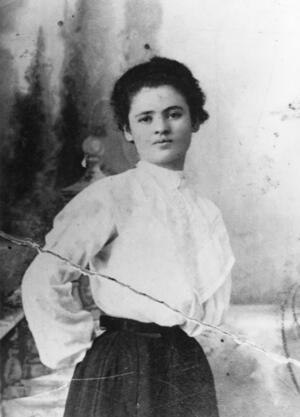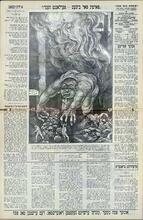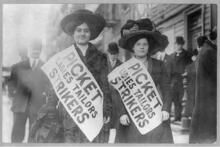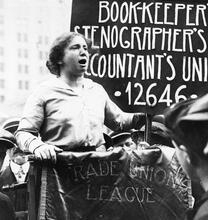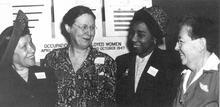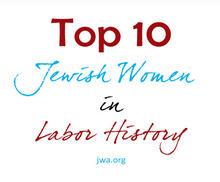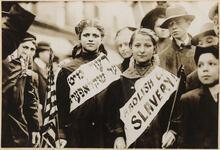Uprising of 20,000 (1909)
On November 23, 1909, more than 20,000 Yiddish-speaking immigrants, mostly young women in their teens and early twenties, launched an eleven-week general strike in New York’s shirtwaist industry. Dubbed the Uprising of the 20,000, it was the largest strike by women to date in American history. The young strikers’ courage, tenacity, and solidarity forced the predominantly male leadership in the “needle trades” and the American Federation of Labor to revise their entrenched prejudices against organizing women. The strikers won only a portion of their demands, but the uprising sparked five years of revolt that transformed the garment industry into one of the best-organized trades in the United States.
Background
Designed in the early 1890s, the shirtwaist (or blouse) arrived at a time when production of women’s clothing moved from the household to the factory. By 1909, 600 shops operated in New York City (the center of garment manufacturing in the United States), employing 30,000 workers and producing fifty million dollars in merchandise annually. The relatively newer shirtwaist factories—generally of medium to large size, employing roughly 50 to 300 people during the busy seasons—provided slightly better working conditions and wages than the older suit and cloak shops, which employed mostly Jewish men.
In the shops, the internal subcontracting system trapped about a quarter of the women in unskilled, poorly paid jobs. These “learners,” so-called even after they mastered their tasks, earned three to four dollars per week (during the busy seasons), while semiskilled “operators,” about 50 to 60 percent of the workforce, earned seven to twelve dollars per week. At the top of the hierarchy stood highly skilled sample makers, cutters, and pattern makers who earned fifteen to twenty-three dollars per week and subcontracted work to “learners.” They were almost exclusively male and the most likely segment of the workforce to be unionized before the uprising.
The division of labor along skill and gender lines reinforced biases among conservative trade unionists against organizing women and unskilled laborers. Although the International Ladies Garment Workers Union did not officially discriminate against women, its conservative leadership (replaced by socialists in 1914) dismissed women as an ephemeral part of the workforce, interested primarily in marriage and motherhood—an opinion shared by Samuel Gompers and many of the AFL’s craft unions. Jewish women did quit working after marriage in significantly higher numbers than their Italian coworkers, but this did not prevent militancy in the workplace or in the community. (Conversely, Italian woman proved difficult to organize.) In fact, an emergent tradition of activism among women (punctuated by the 1902 Term used for ritually untainted food according to the laws of Kashrut (Jewish dietary laws).kosher meat boycott, the 1907 rent strike, and sporadic labor struggles) played a key role in sustaining the 1909 uprising.
The movement that culminated in the uprising of the 20,000 began with spontaneous strikes against the Leiserson Company, the Rosen Brothers, and the Triangle Shirtwaist Company—New York’s largest manufacturer of shirtwaists—(See Triangle Shirtwaist Fire) during the summer/fall busy season of 1909. Although prompted by different incidents, workers shared a common set of underlying grievances about wages, hours, workplace safety, and workplace indignities suffered specifically by women (such as unwanted sexual advances, threats, and invasions of privacy). The Rosen Brothers settled with their employees after five weeks, but Leiserson and Triangle remained intransigent.
From the outset, the young strikers faced three-way opposition from the manufacturers, the police, and the courts. Triangle and Leiserson hired thugs and prostitutes to abuse strikers, often with aid from policemen, who then arrested strikers on trumped-up charges of assault. In court, strikers faced hostile magistrates who upbraided the young women (“You are striking against God and nature,” scolded one enraged judge), fined them, and, in some cases, sentenced them to the workhouse.
In an attempt to curb abuses, the fledgling Local 25 of the ILGWU, which represented shirtwaist makers, asked the Women’s Trade Union League (WTUL) (established by upper-class suffragists in 1904 to promote the welfare of working women) to monitor the picket lines. After police arrested Mary Dreier, head of the WTUL, for allegedly harassing a scab, strikers won the sympathy of a previously indifferent public. The WTUL proved a valuable ally; its members walked the picket lines, raised funds, and pleaded the strikers’ case to the general public. The Forverts, the United Hebrew Trades, the Arbeter-ring (Workmen’s Circle), and the Socialist Party and its weekly The Call also provided important logistical and financial support.
Nonetheless, by early November, Local 25 had almost depleted its strike fund, and many strikers chose to return to work rather than suffer arrest, harassment, and personal injury. Furthermore, Triangle and Leiserson partially circumvented the strike by subcontracting work to smaller shops (though, on at least one occasion, subcontracted workers went on a sympathy strike). Instead of conceding defeat, Local 25’s fifteen-member executive committee (six of whom were women and all socialists) called for a general strike to shut down production entirely in the shirtwaist industry.
On November 22, thousands of young women packed into Cooper Union to discuss Local 25’s recommendations. Samuel Gompers and Mary Dreier spoke, along with a number of luminaries of the Jewish labor movement, including Meyer London, labor lawyer and future Socialist Party congressman; Benjamin Feigenbaum, the meeting’s chair and popular Forverts writer; and Bernard Weinstein, head of the United Hebrew Trades. In speech after speech, speakers offered support, but urged caution.
Frustrated after two hours, Clara Lemlich Shavelson—a leader of the Leiserson strike and a member of Local 25’s executive committee—demanded the floor and delivered what the press termed a “Yiddish philippic.” In words now legendary, the impassioned twenty-three-year-old declared, “I am a working girl, one of those who are on strike against intolerable conditions. I am tired of listening to speakers who talk in general terms. What we are here to decide is whether we shall or shall not strike. I offer a resolution that a general strike be declared—now.” Lemlich ignited the audience. In unison, the crowd pledged support for the general strike by reciting a secularly adapted Hebrew oath chanted by Feigenbaum.
The Strike
The following morning, approximately 15,000 shirtwaist workers took to the streets. By evening, the number swelled to more than 20,000. According to some estimates, almost 30,000 workers participated in the strike during its eleven-week duration, 90 percent of whom were Jewish and 70 percent women. “Learners” and “operators” made up the bulk of the strikers, but male craftsmen (who themselves employed “learners” and occupied a critical position in the production process) also marched on the picket line, thereby guaranteeing a complete work stoppage.
Pandemonium reigned during the uprising’s initial days as thousands of workers rushed to meetings, swarmed union locals, and milled the streets. In the confusion, some workers returned to their jobs, demoralized. At the same time, a number of small shops quickly negotiated with the union to gain an edge on their larger competitors. Thus, hundreds of workers returned to their shops, even as hundreds of others joined the picket lines.
Throughout the uprising, arrests and harassment continued unabated. In one month, 723 people were arrested and 19 sentenced to the workhouse. Bail averaged $2,500 per day, and court fines totaled $5,000. Overall, the strike cost $100,000. Clara Lemlich suffered six broken ribs and was arrested a total of seventeen times. In one egregious miscarriage of justice, a ten-year-old girl was tried without testimony and sentenced to five days in the workhouse for allegedly assaulting a scab. In response to such outrages, the WTUL organized mass rallies at the Hippodrome, Carnegie Hall, and City Hall in which the strikers’ plight was connected to the suffragist cause. Although a degree of mutual suspicion existed behind the scenes, this alliance produced a new perspective that merged class consciousness with feminism (later named “industrial feminism”).
“Learners” and “operators” conducted much of the uprising’s daily legwork. These bold young women—malnourished and poorly clad in the bitter winter cold—handed out leaflets, raised funds, distributed strike benefits, scheduled meetings, and maintained the crowd’s morale. Some of the outstanding organizers, such as Clara Lemlich, Pauline Newman, and Rose Schneiderman, had been active in radical politics even before their emigration from Russia. Hundreds of other women assumed leadership roles spontaneously, only to disappear after the strike.
For much of the eleven-week strike, workers and manufacturers were locked in a stalemate. The Associated Waist and Dress Manufacturers, representing the large employers, rejected the closed union shop. Exhausted, but determined, workers refused to budge on this point, fearing that an open shop would leave the union powerless to enforce agreements. However, the strikers (represented at the negotiating table by Socialist Party leader Morris Hillquit and John Mitchell of the United Mine Workers) could not hold out. The general strike was called off unceremoniously on February 15, 1910, with about a thousand workers still on the picket line.
Impact
Though not a complete victory, the uprising achieved significant, concrete gains. Out of the Associated Waist and Dress Manufacturers’ 353 firms, 339 signed contracts granting most demands: a fifty-two-hour week, at least four holidays with pay per year, no discrimination against union loyalists, provision of tools and materials without fee, equal division of work during slack seasons, and negotiation of wages with employees.
By the end of the strike, 85 percent of all shirtwaist makers in New York had joined the ILGWU. Local 25, which began the strike with a hundred members, now counted ten thousand. Furthermore, the uprising laid the groundwork for industrial unionism in the garment industry. Inspired by the shirtwaist makers, sixty thousand cloak makers—men, this time—launched the Great Revolt in the summer of 1910, and other garment strikes ensued across the country. After five years of unrest, the “needle trades” emerged as one of the best organized in the United States.
Less tangible, but equally important, the general strike convinced conservative veterans to accept women as capable union activists. The young women themselves discovered their own self-worth through the ideological ferment and economic struggles of 1909–1910. Many of them remembered the Uprising of the 20,000 as the formative event of their adult lives.
Baum, Charlotte, Paula Hyman, and Sonya Michel, eds. The Jewish Woman in America (1976).
Epstein, Melech. Jewish Labor in USA: An Industrial, Political and Cultural History of the Jewish Labor Movement (1969).
Glenn, Susan A. Daughters of the Shtetl: Life and Labor in the Immigrant Generation (1990).
Hyman, Paula. “Immigrant Women and Consumer Protest: The New York City Kosher Meat Boycott of 1902.” AJH 70, no. 1 (September 1980): 68–90.
Kessler-Harris, Alice. “Organizing the Unorganizable: Three Jewish Women and their Unions.” Labor History 17, no. 1 (Winter 1976): 5–23.
Levine, Louis. The Women Garment Workers: A History of the International Ladies’ Garment Workers’ Union (1924).
McCreesh, Carolyn Daniel. Women in the Campaign to Organize Garment Workers 1880–1917 (1985).
Orleck, Annelise. Common Sense and a Little Fire: Women and Working Class Politics in the United States, 1900–1965 (1995).
Seller, Maxine Schwartz. “The Uprising of the Twenty Thousand: Sex, Class and Ethnicity in the Shirtwaist Makers’ Strike of 1909.” In ‘Struggle a Hard Battle’: Essays on Working-Class Immigrants, edited by Dirk Hoerder (1986).
Tax, Meredith. The Rising of Women: Feminist Solidarity and Class Conflict, 1880–1917 (1980).
Tyler, Gus. Look for the Union Label: A History of the International Ladies’ Garment Workers’ Union (1995).
Waldinger, Robert. “Another Look at the International Ladies’ Garment Workers’ Union: Women, Industry Structure and Collective Action.” In Women, Work and Protest: A Century of U.S. Women’s Labor History, edited by Ruth Milkman (1985).


